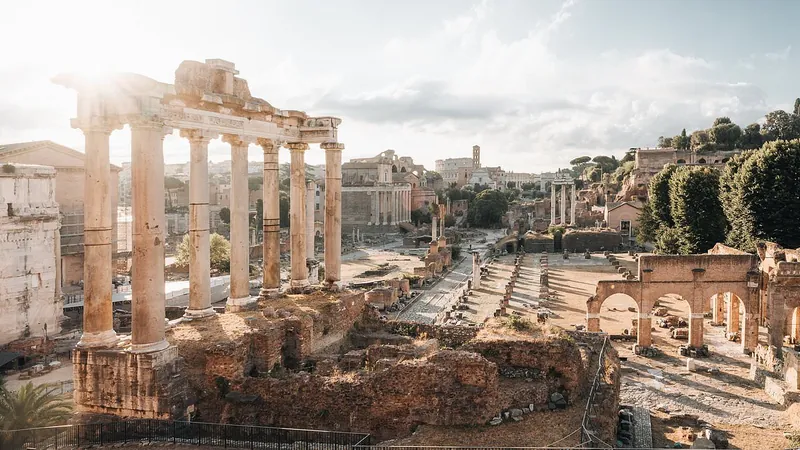
Unearthed Secrets: What Truly Led to the Collapse of the Roman Empire 1,500 Years Ago?
2024-11-16
Author: Ting
Introduction
In a groundbreaking new study, scientists have revealed surprising revelations about the reasons for the eastern Roman Empire's dramatic collapse 1,500 years ago, shedding light on historical narratives long thought settled. This research challenges conventional theories and provides fresh insights into a pivotal moment that paved the way for the rise of Islam and the end of one of human history's most powerful civilizations.
Miscalculations and Military Weakness
The researchers highlighted a grave miscalculation by the Romans regarding their longstanding rivals, the Persians. This underestimation not only weakened their military stance but also disrupted crucial trade routes, leading to economic instability and a mass exodus of people from the empire. Trade, which had once flourished, became a casualty of war, significantly undermining the empire's economic foundations.
War with Persia and Economic Collapse
The war between Rome and Persia spanned from 54 BC to 628 AD, with both sides vying for dominance over key territories. However, the turning point came when the Persians successfully seized control over vital Roman trade routes, critical for their economic survival. Without access to these routes, the Roman economy crumbled, prompting citizens to seek refuge in cities like Constantinople.
Shipwrecks and Maritime Decline
Delving deeper into the crisis, the research team analyzed shipwrecks scattered throughout the Mediterranean, notably in Marseille, Naples, Carthage, eastern Spain, and Alexandria. They discovered a startling trend: Roman ships, which once thrived in the region, plummeted in number by the latter half of the 7th century, leaving only a handful behind. This decline in maritime activity reflected the empire’s weakening economic power.
Evidence of Economic Vitality
Tens of thousands of Roman goods from critical regions—including Israel, Tunisia, Jordan, Cyprus, Turkey, Egypt, and Greece—painted a picture of a civilization still engaged in trade. In fact, rather than witnessing a decline in prosperity in the second half of the 6th century, researchers found evidence of growth in demographics and economic output. “The decline was not immediate; rather, it followed a disruption in trade and military failures,” according to the authors, Lev Cosijns and Haggai Olshanetsky from the University of Oxford.
Contradicting Previous Accounts
Previous accounts suggested that a plague around 543 AD or a significant climate shift peaked around the mid-6th century dealt a devastating blow to the empire. Yet the latest findings indicate that the Roman Empire was at its zenith during this period. “The year 536 CE wasn’t the worst for everyone,” remarked Cosijns, noting that while Scandinavia faced difficulties, the eastern Roman Empire enjoyed relative stability.
Dating Artifacts and Industrial Growth
The researchers' investigation began with the dating of pottery artifacts unearthed in Nessana, Israel, a city that thrived in trade during the late 6th and early 7th centuries. Over 16,000 pottery pieces uncovered there not only confirmed the region’s commercial vitality but also indicated a notable increase in industrial activity post-550 AD.
Maritime Activity Over Time
Using data from the Harvard University shipwreck database and the Oxford Roman Economy Project, they established a timeline tracking Roman maritime activity. For instance, they observed that shipwrecks remained stable at around 200-300 every 50 years during the 2nd century AD. However, by the late 5th century, there was an alarming 50% decline attributable to the Western Roman Empire's downfall, which fundamentally weakened trade and shipping routes.
Territorial Struggles and Military Actions
The findings also highlighted the intense territorial struggle between the Roman and Persian Empires. Control over regions like Armenia, Mesopotamia, and northern Syria was critical for maintaining border security and trade access. The Roman military did experience brief success under Emperor Heraclius, who launched impactful counteroffensives; however, the long-term effects of disrupted trade routes and subsequent losses to Islamic forces culminated in the empire’s gradual decline.
Cautions Against Oversimplification
Interestingly, these revelations contradict the narrative that links the empire's fall solely to climate change or disease. Researchers cautioned against oversimplifying historical events by attributing them to one or two factors. “This is especially misleading given that we face a contemporary climate crisis,” Olshanetsky and Cosijns explained.
Lessons for the Present
Could it be that the lessons of the past offer us critical insights into our present challenges? As we grapple with climate issues and geopolitical tensions, this ancient story serves as a reminder: sometimes, the collapse of great civilizations may hinge on miscalculations as monumental as the lost art of negotiation and trade.



 Brasil (PT)
Brasil (PT)
 Canada (EN)
Canada (EN)
 Chile (ES)
Chile (ES)
 España (ES)
España (ES)
 France (FR)
France (FR)
 Hong Kong (EN)
Hong Kong (EN)
 Italia (IT)
Italia (IT)
 日本 (JA)
日本 (JA)
 Magyarország (HU)
Magyarország (HU)
 Norge (NO)
Norge (NO)
 Polska (PL)
Polska (PL)
 Schweiz (DE)
Schweiz (DE)
 Singapore (EN)
Singapore (EN)
 Sverige (SV)
Sverige (SV)
 Suomi (FI)
Suomi (FI)
 Türkiye (TR)
Türkiye (TR)